Dee Estuary Birding
Monthly Newsletter...
April 2021 Newsletter
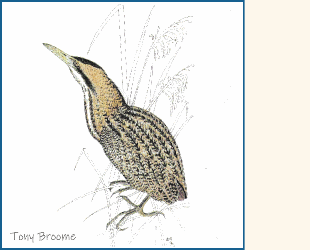
Rewilding Hoylake Langfields (a
fantasy?)
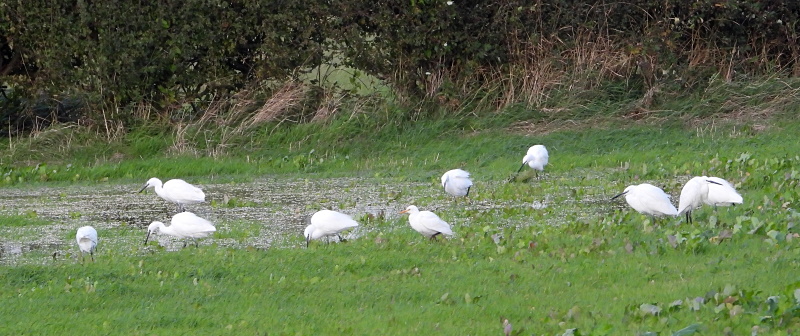
Cattle Egrets are rare birds on these fields but would probably become resident if a reserve was created
Rewilding with species restoration is a
solution to three crises facing humanity - climate change, biodiversity
loss and wellbeing. Amy-Jane Beer (Ref 1).
Those who live locally will have probably realised by now that the Hoylake Golf Resort, first proposed in 2004, is now dead in the water. It may not have been officially canceled by Wirral Council but the political will has evaporated and the money has most certainly dried up. As the proposal included building houses on Green Belt land it never had much public support and I always felt that it was just one councilor's vanity project and he has now retired. So what do we do with these 295 acres?
To me it seems an ideal opportunity for a rewilding
project on land which the Council told us, when justifying the Golf
Resort, is low grade and unproductive. But what exactly is rewilding
and why is it necessary? Several books have been written answering
those very questions and I can't recommend too highly the ones
mentioned in the References/Further Reading section below (Refs. 2, 3 and 4). In this short
article I'll try and give a brief summary.
In this country we pride ourselves on our great conservation societies
and organisations, such as the RSPB, Wildlife Trusts, BTO etc, which
have large memberships, many active volunteers and enthusiastic and
knowledgeable employees, they are the envy of the world. It is ironic,
therefore, that our countryside is one of the most impoverished and
degraded in the world with our wildlife often clinging on in depleted
remnants of barely suitable habitats. It's as though somebody in power
sat down at the end of World War II and drew up a plan on the most
efficient way to destroy our wildlife, and has been carrying that out
ever since with great success as there has undoubtedly been
catastrophic declines of both insects and birds over that period.
Having depressed you all with that here is the good news, there is
light at the end of the tunnel with rewilding becoming more and more
part of main stream thinking and with many notable success stories (see Ref 5).
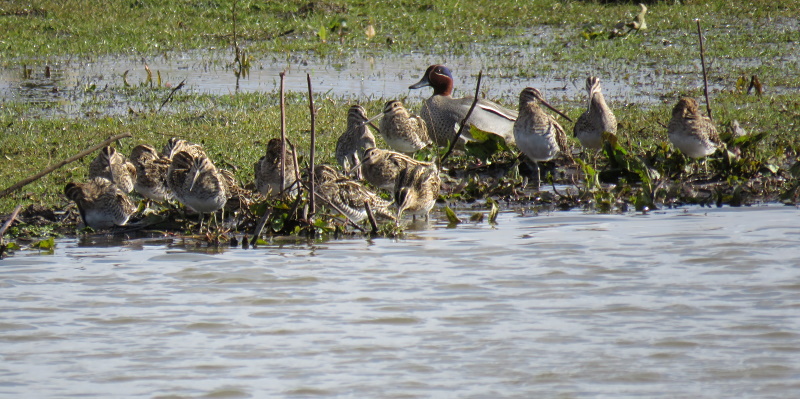
© Richard Smith
Rewilding is about restoring and repairing the land and has resulted in
changing the way we think about how nature works, and what happened in
the past. Take plant succession for example - we've always been told
that if you leave an area of shallow fresh water to its own devices it
will silt up, first turning into reedbeds before scrub invades followed
by trees and it will eventually end up as closed canopy woodland. We've
also been taught that the pre-historic Wild Wood in the British Isles
consisted of closed canopy woodland from coast to coast, and I quote "8,000 years ago, Britain had so many trees that a squirrel could go from John
O'Groats to Land's End without touching the ground". But
we now know that is all just baloney. Many recent
studies and direct observation of rewilded areas have proved without
doubt that it just didn't happen like that - there would have been a
whole mosaic of habitats including extensive grasslands and wetlands.
Benedict MacDonald (author of
Rebirding) reckons around 20% of the land would have been
underwater in one form or another. So how can the theory of plant
succession be so wrong? Because it takes no account of the huge impact
made by animals. To quote Dutch ecologist Frans Vera "Animals are
drivers of habitat creation, the impetus behind biodiversity. Without
them you have impoverished, static, monotonous habitats with declining
species. It's the reason so many of our efforts at conservation are
failing".
You will hear the phrase 'Keystone Species' again and again with rewilding and these mainly fall into the category of herbivorous animals such as cattle, horses, deer and beavers, and add to that the omnivorous pig. Deer and Beavers are, of course wild animals, and in the 'wild wood' there would also have been Aurochs and Bison (wild cattle), Tarpan (wild horses) and Wild Boars, but where wild animals such as these aren't available then hardy old domestic breeds such as Longhorn cattle, Exmoor ponies and Tamworth pigs are a good substitute. It is these animals in their different ways - grazing, browsing, digging and dam building - that create habitat diversity and with it abundant wildlife with birds, insects, wild flowers and the rest (Ref 6). Rewilding is often associated with reintroducing species but it's more about providing conditions in order that nature can be left to create the right habitats so that species can make a comeback, either naturally or through reintroduction schemes.
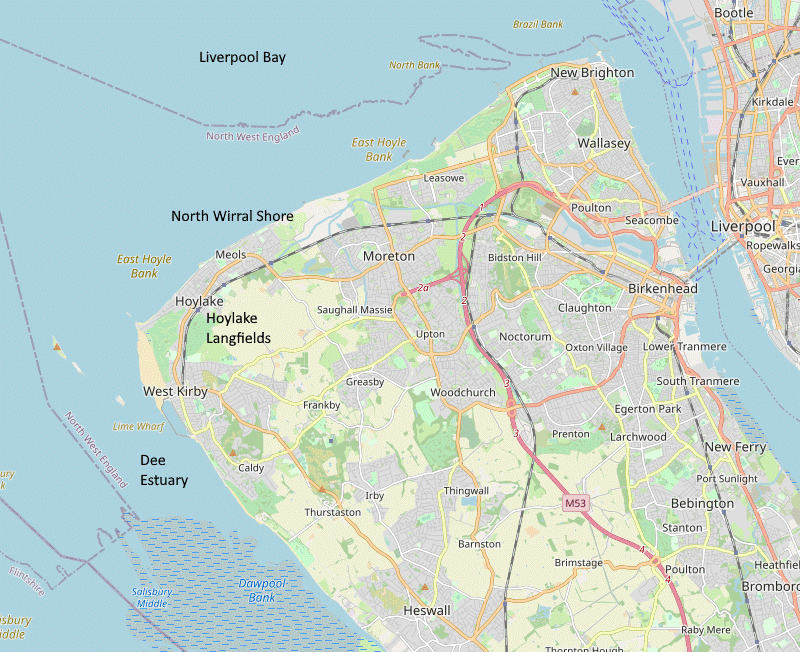
The
location of the Hoylake Langfields on the north-west corner of the
Wirral Peninsula.
© OpenStreetMap contributors https://www.openstreetmap.org/copyright
What I had in mind for the Hoylake Langfields would
be to make them into a Nature Reserve, so by definition that means
rewilding them but exactly how that would be achieved I would leave to
the experts. At 295 acres these fields may be a bit small for a full on
rewilding project, which are normally associated with areas of land
consisting of several thousand acres (for example the Knepp estate is
3,500 acres), but it is certainly large enough to make a fabulous
nature reserve being slightly larger than both RSPB Burton Mere
Wetlands and the wild area of WWT Martin Mere. These low lying fields
with a high water table, often flooding in winter, would be turned into
wetlands with reedbeds, wader scrapes, deeper lagoons for ducks and
geese, damp fields and islands for breeding waders and there would
still be plenty of room for woodland, scrub and wild flower meadows.
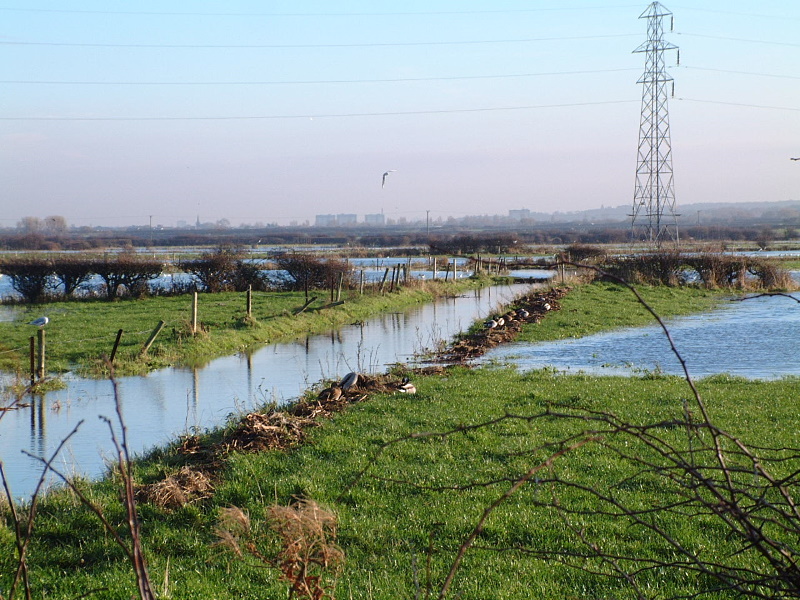
© Richard Smith
With the Dee Estuary just to the west and north Wirral Shore and Liverpool Bay just to the north the reserve would be in an ideal place, many birds already fly over these fields every day as they travel between the two areas as well as passage migrants flying down the coastline. With the proximity of the West Kirby and Hoylake high tide roosts the reserve would itself become a major roost site and refuge for waders which are often disturbed by the many dogs and walkers on the beaches. Such a wetland reserve would also attract exciting birds such as Short-eared Owls, Hen Harriers, Marsh Harriers and Bitterns.
Currently permanent shallow fresh water is in very short supply in North Wirral but to get an idea of the potential of this site I give two examples of what happens when shallow fresh water is available. The first is the 'Gilroy Scrape'. This was a permanent flood caused by a blocked drain which was in a small paddock of just five acres on the southern edge of Hoylake Langfields next to Gilroy housing estate. Unfortunately it was drained in 2016 but up until then it regularly held around 5% of the entire Icelandic race of Black-tailed Godwits as they moulted here in late summer and autumn which meant it was one of the most important sites for this sub-species in Europe with numbers typically reaching two to four thousand (Ref 7). It also attracted up to a hundred Redshanks and Common Snipes plus regular visits of Common, Green and Wood Sandpiper on passage, as well as a good selection of wildfowl including Garganey, Shelduck and Shoveler. The other site is also just another small paddock of around five acres. This was basically an area of wasteland on the edge of Moreton which last year (2020) was dug out to create a flash to attract birds, and within weeks it was doing just that. In the summer there were huge numbers of hirundines feeding overhead and this last winter (2020/21) there were up to 62 Shovelers, three Water Rails, over 20 Common Snipe, 35 Mallard, three Tufted Duck, several Teal and a Greenshank. As the saying goes - provide the habitat and the birds will come!
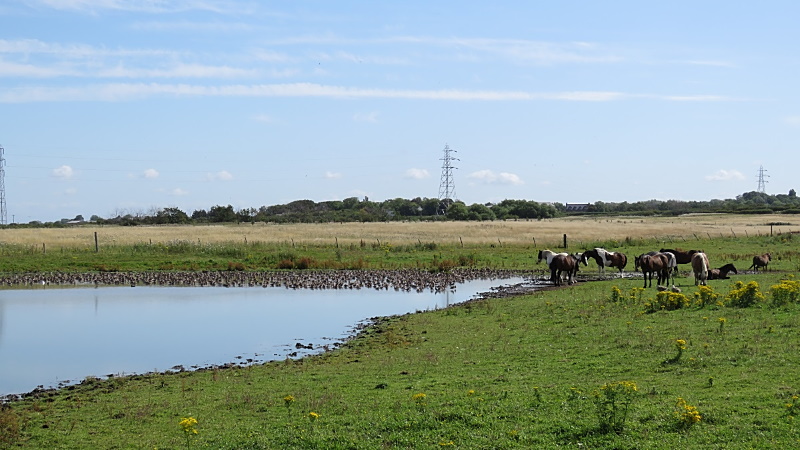
Peaceful scene at Gilroy Scrape in August 2015, several hundred Black-tailed Godwits in the water and attendant herbivores on the right. Horses kept the grass short which was essential for attracting the godwits. © Richard Smith
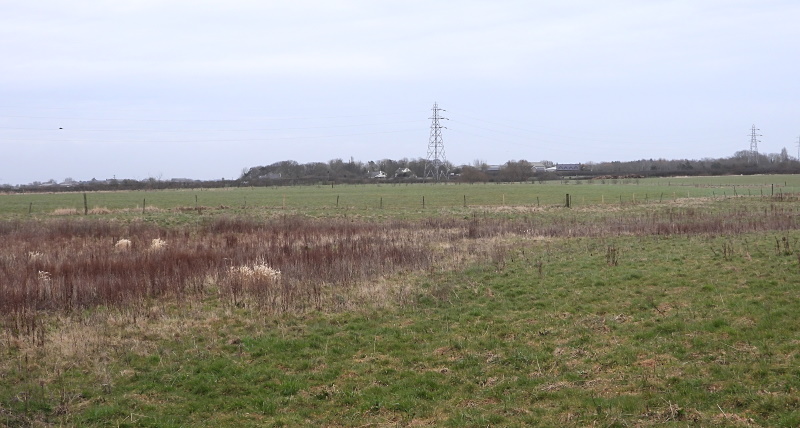
The same view in March 2021. After draining the scrape in 2016 the farmer regrettably abandoned the field and this is now what it looks like after a couple of years of no horse grazing. It is now completely unsuitable for waders and wildfowl and looks a mess with rampant 'weeds'. But even looking like this it is better wildlife habitat than the hedgeless field beyond, even so it would be much better to restore the scrape and this could then be incorporated within any Hoylake Langfields Nature Reserve © Richard Smith
Although creating some fantastic habitat for
wildlife, particularly birds, would be a primary aim of any reserve I
envisage education to be just as important. Situated next to Hoylake
and West Kirby there are several schools within an easy walk of the
Hoylake Langfields, with many more schools just a short drive away in
the rest of Wirral and, indeed, the whole of Merseyside. This would be
an ideal opportunity to provide world class wildlife educational and
research facilities something along the lines of WWT Martin Mere which
has over 10,000 school children visiting each year (Ref 8). It would also be a boost
for the tourist economy and visitors would be able to come by train as
well as car with Hoylake Station immediately adjacent to the proposed
reserve. Below is an example of what WWT provides for teachers:
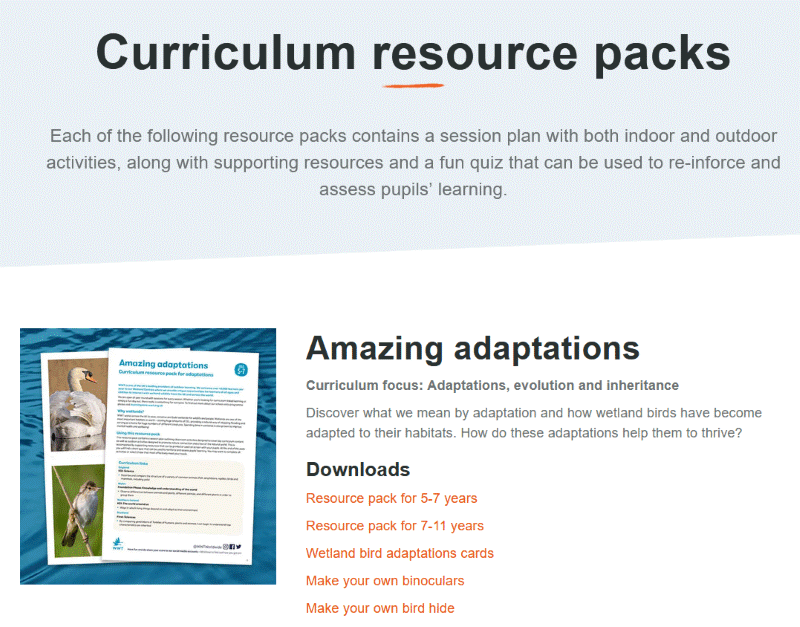
An example of what
the Wildfowl and Wetlands Trust makes available to teachers (screenshot
from https://learningzone.wwt.org.uk/).
All this, of course, is currently just a fantasy and
I'm not aware of any serious plans for the Hoylake Langfields although
I'm not the first to propose some kind of Wetland Centre (see Ref 9). But with rewilding
becoming more and more in the public eye and Wirral Council having 295
acres of land they don't know what to do with, you never know what
might happen.
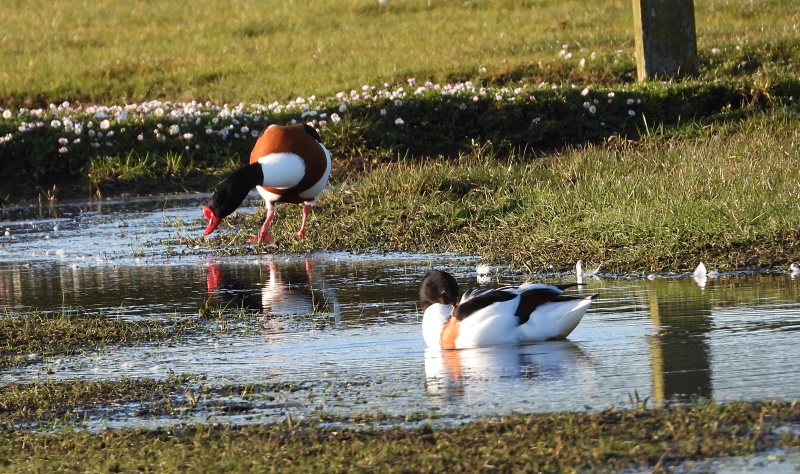
beautiful ducks on the Langfields if it was made into a reserve © Richard Smith
Further Reading/References
1. Amy-Jane Beer, Lost and Found, Waterlife (WWT
Magazine), 214 November 2020/February 2021.
2. Isabella Tree, Wilding,
Picador, 2018 (about the remarkable
wilding experiment which has taking place on the Knepp Estate, West
Sussex).
3. Benedict MacDonald, Rebirding - Restoring Britain's Wildlife, Pelagic Publishing, 2019.
4. Derek Gow, Bringing Back the Beaver, Chelsea Green, 2020.
5. Rewilding Britain Website - "Think Big. Act
Wild.". https://www.rewildingbritain.org.uk/.
6. K. H. Hodder et al., Large herbivores in the wildwood and modern naturalistic grazing systems, English Nature (Report 648), 2005.
7. Richard Smith, The Godwits of Gilroy, September
2015 Dee Estuary Newsletter,
http://www.deeestuary.co.uk/news0915.htm.
8. Wildfowl and Wetlands Trust - The Learning Zone, https://learningzone.wwt.org.uk/.
9. Proposals for a Hoylake Eco-Golf Resort ,
Wildfowl and Wetland Centre; a leaflet published by Hoylake Village
Life in 2011 and revised in 2017:
http://hoylakevision.org.uk/wp-content/uploads/2017/03/Eco-resort_Layout-1_2017_UPDATE_LOWRES.pdf
Richard Smith
Colour Ring Report
Shelducks
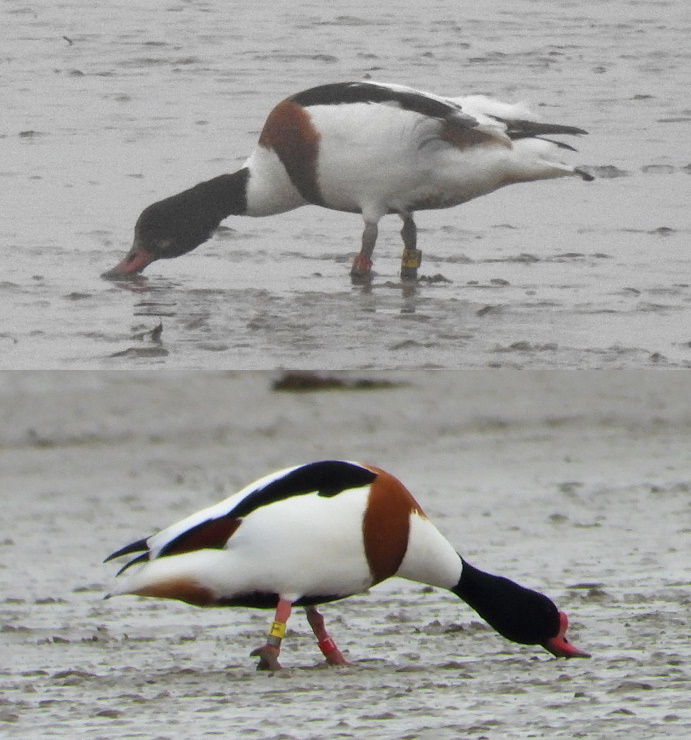
Bottom - Shelduck Red T Yellow F at Meols, March 19th 2021 © Richard Smith
These two Shelduck were both ringed at Wheldrake, Lower Derwent
Valley NNR (SE of York) on 25/11/2020 and both were caught in a second
catch at the same location the following day.
Red U Yellow F was recorded at
Thurstaston on 18/3/2021.
Red T Yellow F was recorded at
Meols on 19/3/2021.
These are the seventh and eighth Shelducks seen on
the Dee Estuary which have been ringed at the Lower Derwent Valley NNR,
an
interesting and unexpected connection between the two sites. These two
will probably have been on their way back to the Dee Estuary after
moulting on the Waddensea in late summer.
Knots
A new Photographic Guide to Colour-ringed Red Knot has been published which should prove very useful to all colour ring enthusiasts - Click Here to download it (PDF File). Also for those wondering what the Dutch ringing codes for waders such as N8RYYN and Y4RNRR actually mean here is a guide to download - Click here (PDF file).
No new records in March but I will be writing a
summary of the excellent 2020/21 season sometime in the next few
months, before the Knot return.
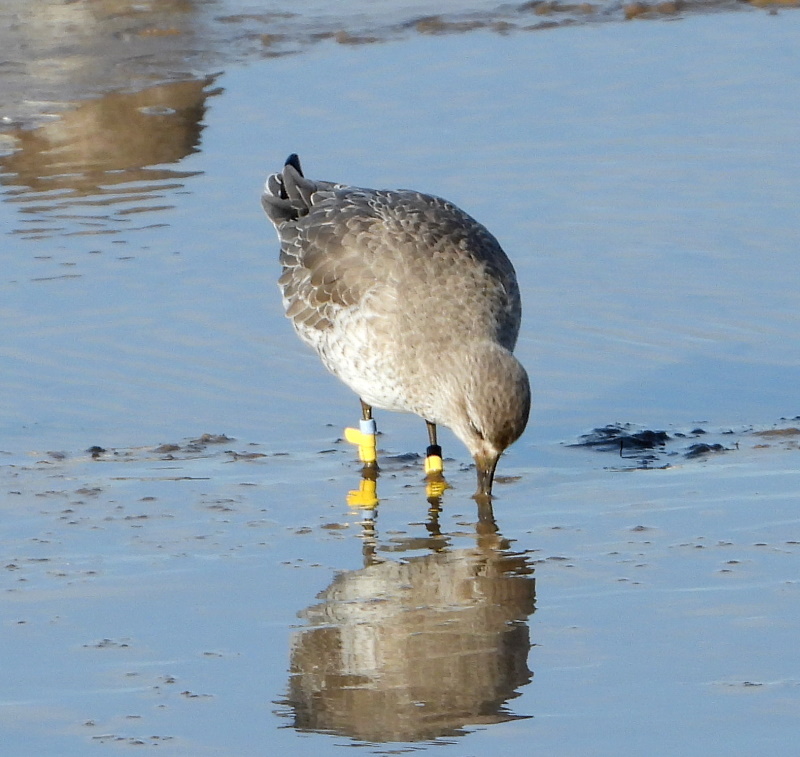
Black-headed Gull
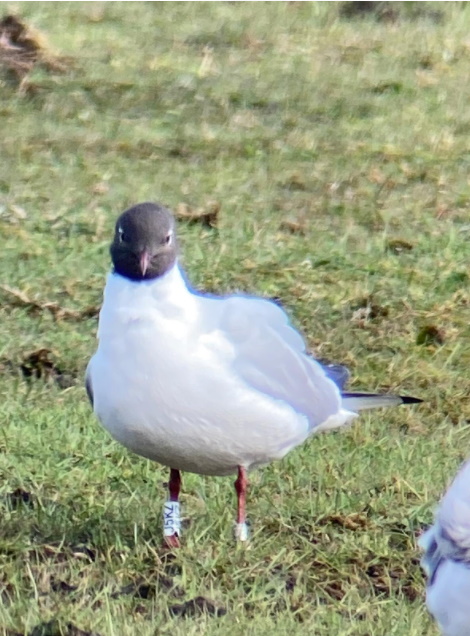
Ringed at Ulsrudvann Lake, SE of Oslo, on 16/6/2012, as a chick.
Recorded back at Oslo in spring and summer every year since, including April and May 2020.
Recorded at Kerr's Field, Leasowe, on 12/3/2021 - first record away from Oslo.
Mediterranean Gull
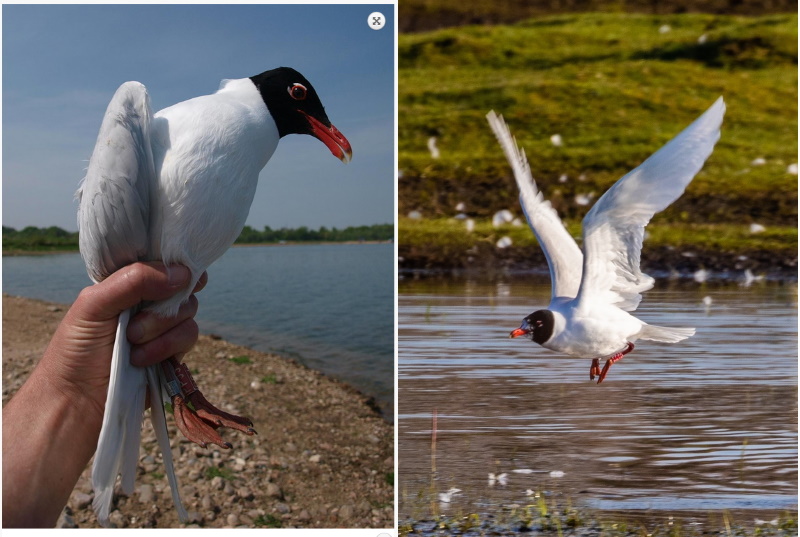
Left - in Poland when re-caught in May 2020 © Maciej Gajewski
Right - in Kerr's Field in March 2021 © Peter Sutton
PPJ3 - white
on red ring.
Ringed near Wojcice, SW Poland in 4/6/2015, as a chick.
Recorded:
July 2015 in the Netherlands.
April 2016 on the Farne Islands.
May 2017 in western Poland.
September 2017 on Hoylake shore.
March 2018 at Old Moor Wetlands, Yorkshire.
It was breeding in May both in 2018 and 2019 in NE Germany.
March 2020 in Kerr's Field, Leasowe.
Breeding close to it's ringing site near Wroclaw, Poland. As seen in
above photo it was recaught by a ringer whilst on nest which had two
eggs.
6/3/21 and 7/3/21 at Kerr's Field, Leasowe.
Shag
Not a colour-ringed bird but one with a metal ring
unfortunately found dead on Leasowe Shore:
Ring No. 1496231
Ringed at Puffin Island, Anglesey, on 14/6/2017, as an adult.
Found dead at Leasowe Shore on 18/3/2021.
Colour-rings were recorded by Richard Smith, Steve
Hinde, Peter Sutton, Sean O'Hara, Graham Connolly and Sue Titchmarsh.
March Bird News
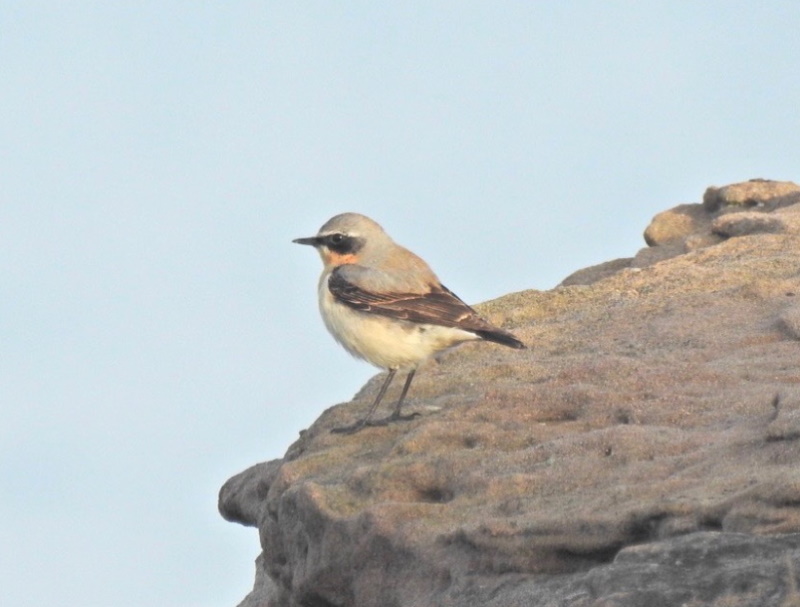
The first spring migrants were generally early
this year, some warm
southerlies in late February seemed to have pushed them on despite a
return to more wintry weather in March. The first Wheatear was
exceptionally early on February 28th, but then we had to wait over
three weeks for the second one on March 23rd which was the same day we
had a nice early Willow Warbler. Normally these first birds come in
singles so it was unusual to get 16 House Martins at Burton Mere
Wetlands on the 27th, another early date. Several had been seen
elsewhere in Cheshire the previous few days including five at
Comberbach so perhaps not as unexpected as we first thought.
| Species | 2021 | Location | 2020 | 2019 |
|---|---|---|---|---|
| Wheatear | 28th Feb |
Leasowe | 16th March |
27th Feb |
| Sand Martin | 5th March |
Burton | 16th March | 16th Feb |
| White Wagtail |
16th March | Leasowe | 1st March |
28th Feb |
| Swallow | 18th March | Leasowe | 23rd March | 21st March |
| Willow Warbler | 23rd March | Leasowe |
26th March | 24th March |
| House Martin | 27th March |
Burton | 5th April |
31st March |
| Whitethroat | |
|
8th April | 14th April |
| Swift | 21st April | 23rd April | ||
| Cuckoo | |
|
23rd April | 18th April |
Another early spring migrant was a Ring Ouzel at Burton on the 8th,
which we think is the earliest ever recorded in Wirral. Another arrived
at Leasowe on the more usual date of the 23rd and stayed for several
days. These March Ring Ouzels will be British breeders, most likely
Scotland, with Scandinavian breeding birds not coming through until the
second week in April.
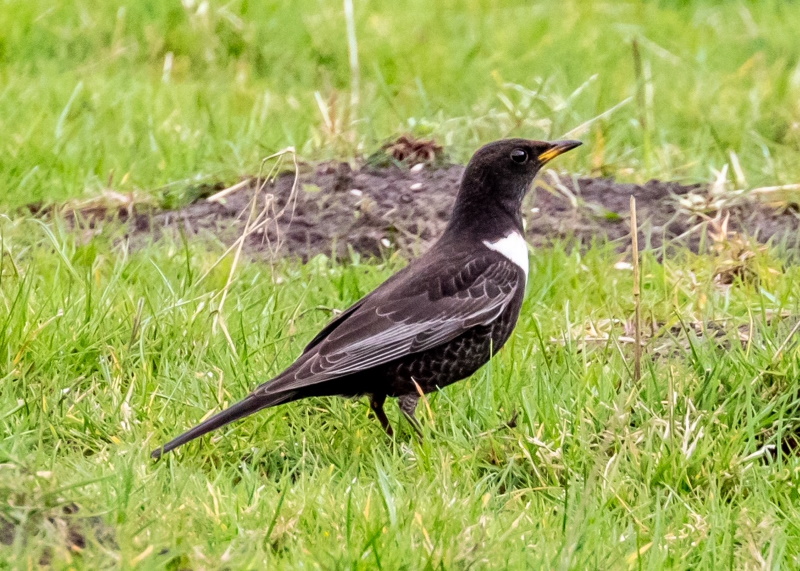
Both the Crossbills, at Ness, and the Snow Buntings,
at Hoylake, were still present at the beginning of the
month. Having spent much of the winter on the wet sand and proto sand
dunes the Snow Buntings decided in March that they liked the rocks by
the Lifeboat Station, this certainly made for some good photo
opportunities and it meant the birds could also find shelter and hide
among the rocks safe both from dogs and over enthusiastic photographers
and birders!
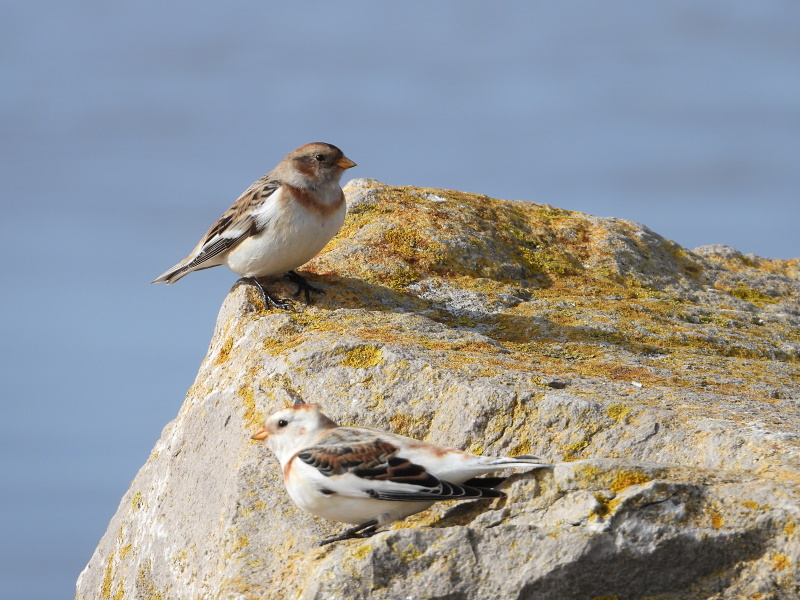
Little Gulls started coming through on the early
date of the 4th, with five off Leasowe, and in total there were five
days when we had counts in double figures with the max count of 63 off
Hilbre on the 23rd, the highest count since 115 in
April 2016. An early Manx Shearwater was spotted during a strong
south-westerly on the 29th, more expected was the first Sandwich Tern
on the same day. A count of at least 40 Gannets on the 12th was a good
number for March.
Brent Geese reached 417 around Hilbre, the highest
count of the winter. Small flocks were dispersed around the estuary
being seen on West Kirby Marine Lake, Thurstaston, Meols, Leasowe and
Gronant.
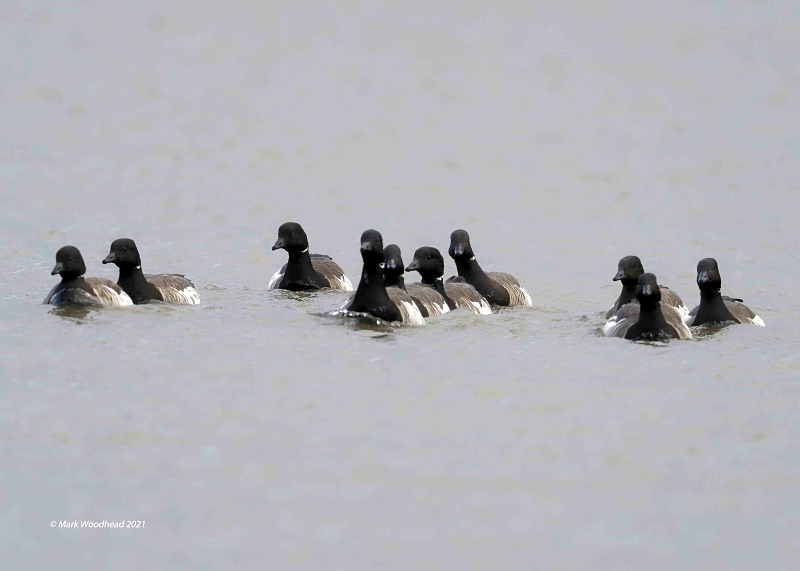
There was plenty going on at Burton Mere Wetlands including a booming Bittern, a first for the Dee Estuary, which also gave some great photo opportunities. Avocets had reached 89 by the month-end, a pair of Marsh Harriers were seen nest building and the presence of several Cattle Egrets and Great Egrets in the area means both species may also breed again. After being absent for most of the winter two Short-eared Owls appeared over the spring tides off Gayton on the 29th and 30th.
Rarer and scarce birds included an Iceland Gull at Oakenholt on the 14th, at least four Twite at Parkgate on the 24th with six there on the 30th (also, more expected, seven were at Flint on the 23rd), a Little Ringed Plover at Leasowe on the 21st and a Lapland Bunting at Hilbre on the 22nd. With a big influx of Russian White-fronted Geese into the country earlier in the winter it's a bit disappointing that we've only seen a handful here with three at Burton on the 5th and single there on the 31st.
Four Ospreys in two days, on the 30th and 31st,
meant a splendid end to the month.
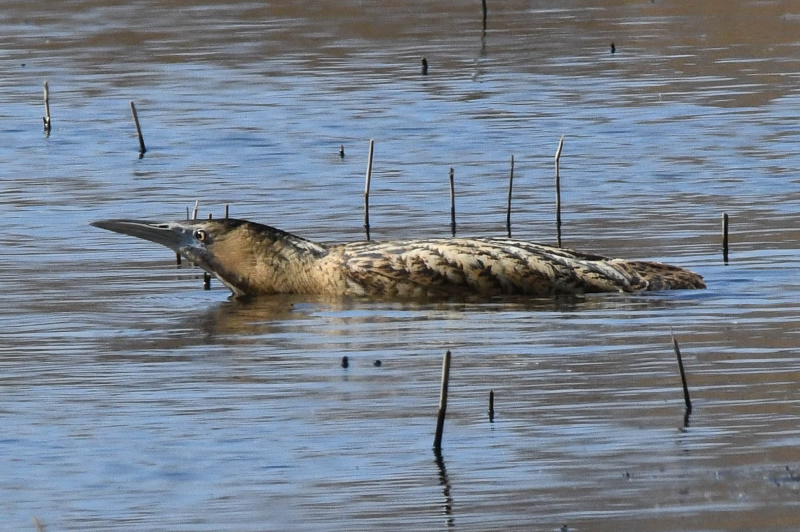
What to expect in April
Spring migration really gets into full swing in
April. Exactly what we
see, where and when depends on the weather but there's always plenty
going on. Out to sea there will be terns on passage starting with
Sandwich
Terns followed by Arctic Terns later in the month with
Black Terns are always a possibility. Also out to sea look out for
Gannets, with the right conditions there will be hundreds out in
Liverpool Bay.
Black-tailed Godwits will be heading towards Iceland, they will stopover on the Dee estuary for a week or two at Burton Mere Wetlands, Caldy Wildfowl Collection and the Connah's Quay reserve looking magnificent in full breeding plumage. The second half of the month will see good numbers of Whimbrels with Heswall and Hilbre being prime locations, and a couple of years ago a small flock fed in a wet field near Leasowe Lighthouse for a few days giving really good views. Another wader to look out for are Avocets and these should reach over 100 at Burton Mere Wetlands. Some pause here before heading further north to breed, whilst others will stay and nest on the reserve.
Early in April the Pink-footed Geese will leave us, usually in several large spectacular flocks. Any large gull overhead is worth checking out, it may actually be an Osprey!
But the main focus for we birders in April is the
passerine migration. The second half of the month should see the
largest numbers including Common Redstarts, Wheatears, Ring Ouzels,
Yellow Wagtails, White Wagtails and Whinchats. Look out for spectacular
falls - some mornings we can go out and every bush seems full of Willow
Warblers and every field full of Wheatears, whilst the wet sand at
Hoylake and Gronant is carpeted with White Wagtails. Other warblers
will include Grasshopper Warblers with the much rarer Wood Warbler
always a possibility. Early morning is generally best with hotspots
being the Leasowe Lighthouse area, Red Rocks marsh and dunes, Hilbre
and the Warren/Sand Dunes at Point of Ayr.
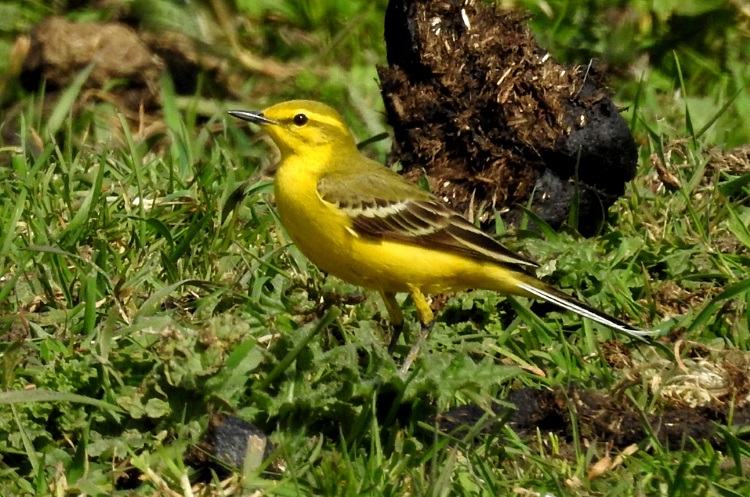
Forthcoming Events
April Highest Spring Tides (Liverpool)
Also see Tides page.
27th April, 12.00hrs (BST), 9.9m.
28th April, 12.43hrs (BST), 10.0m.
29th April, 13.28hrs (BST), 9.9m.